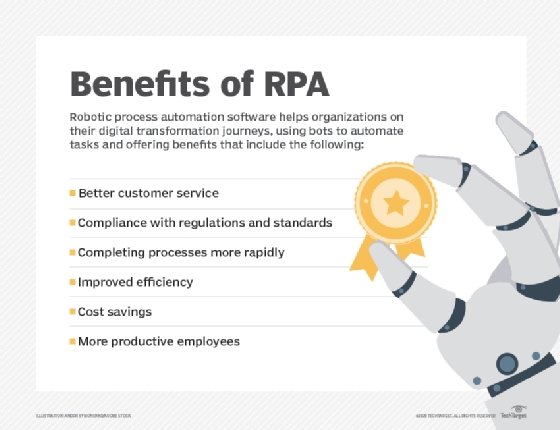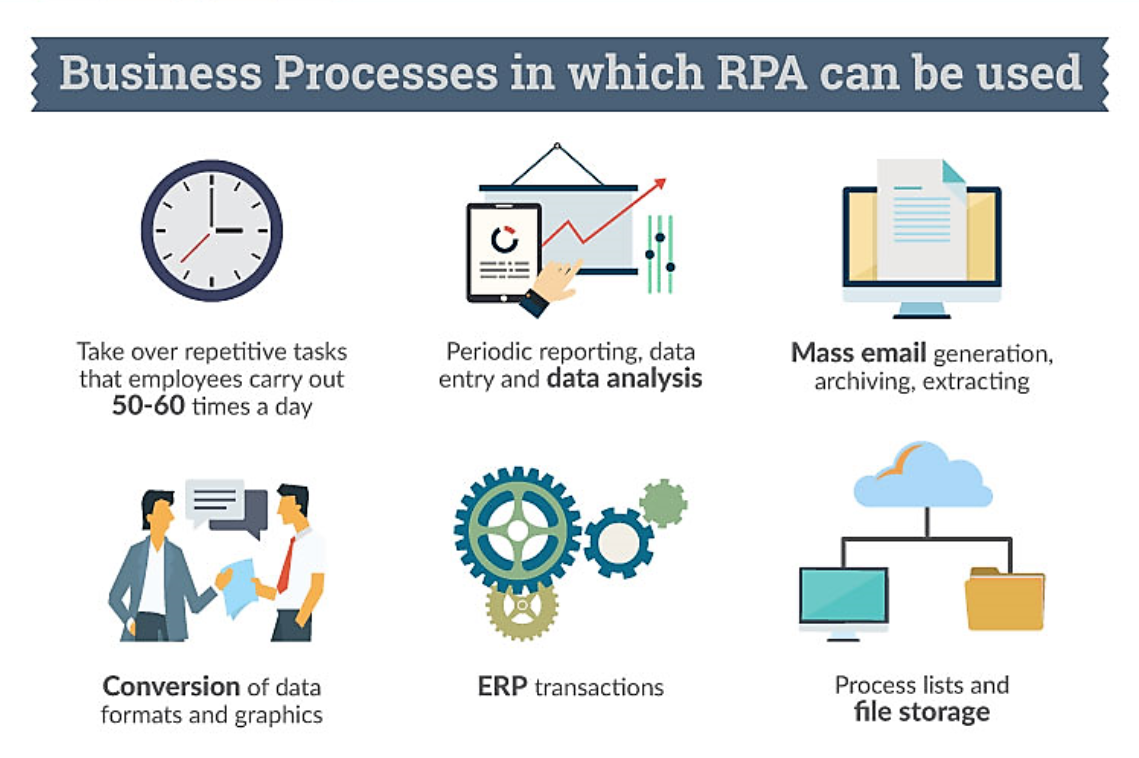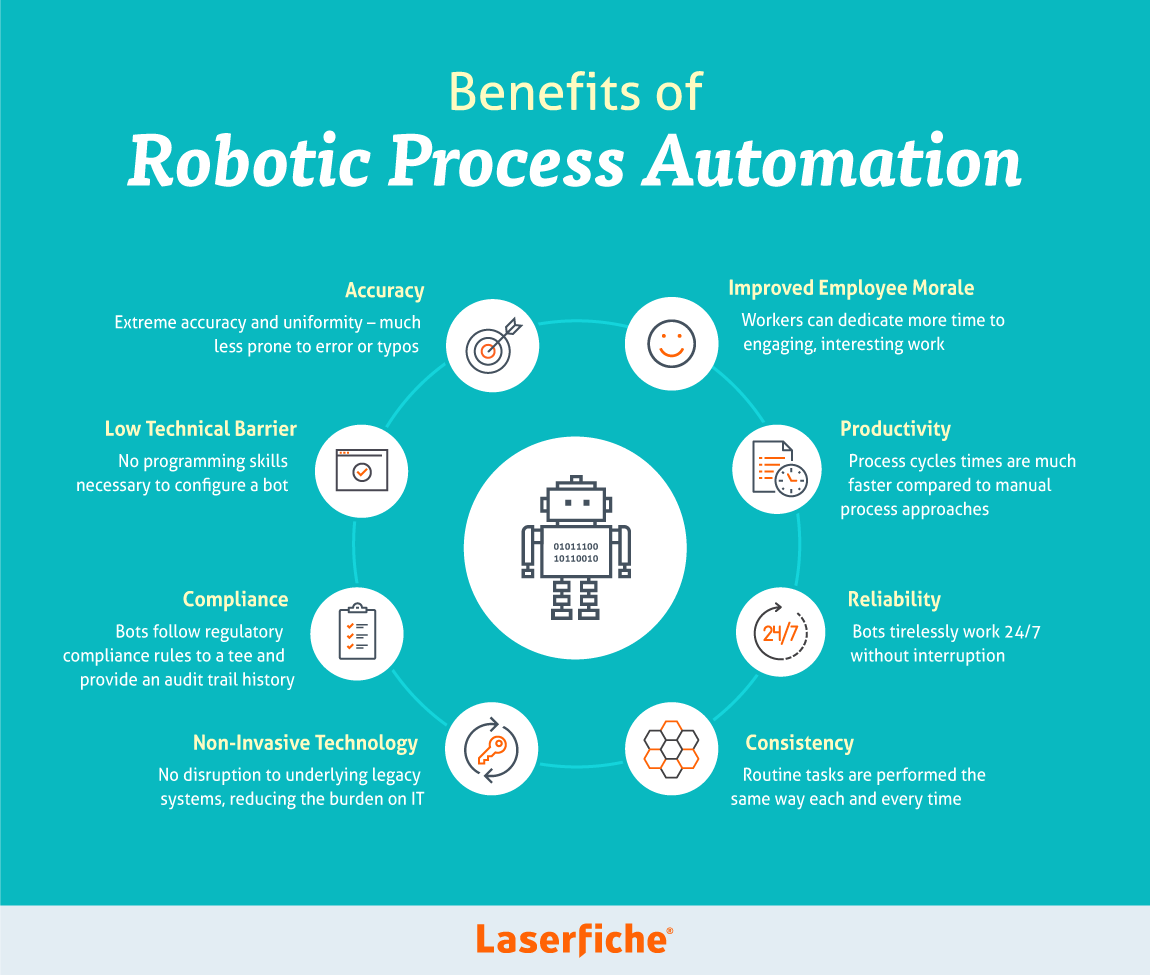RPA (Robotic Process Automation) uses software robots to automate repetitive tasks. It improves efficiency and reduces human error.
RPA is transforming business operations by handling mundane tasks. It frees up human workers for more strategic activities. Companies across various industries use RPA to streamline processes like data entry, invoice processing, and customer service. Software robots mimic human actions, interacting with applications and systems.
RPA tools can integrate with existing IT infrastructure without complex programming. This makes implementation cost-effective and scalable. Organizations benefit from reduced operational costs and faster processing times. RPA also enhances accuracy and compliance. As technology evolves, RPA continues to offer new possibilities for business optimization. Embracing RPA can lead to significant competitive advantages.

Credit: www.techtarget.com
Key Components
Understanding the key components of RPA automation is crucial. These components make RPA powerful and efficient. Let’s dive into the essential parts that drive RPA technology.
Software Robots
Software robots are the backbone of RPA automation. They mimic human actions on a computer. These robots perform repetitive tasks with high accuracy. They can work 24/7 without getting tired. Software robots interact with applications and systems just like humans. They can log in to applications, move files, and fill in forms. They can also extract and process data with precision. These robots are programmed to follow specific rules and workflows. This makes them reliable and consistent in their tasks.
Automation Platforms
Automation platforms are the environments where software robots operate. These platforms provide the tools to create, deploy, and manage robots. They offer user-friendly interfaces for designing workflows. Automation platforms support integration with various applications and systems. They ensure security and compliance in automation processes. These platforms also provide analytics and reporting features. This helps in monitoring the performance of software robots. Popular automation platforms include UiPath, Blue Prism, and Automation Anywhere.
| Component | Function |
|---|---|
| Software Robots | Perform tasks with high accuracy and speed |
| Automation Platforms | Provide tools and environments for robot operations |
Understanding these components is key to leveraging RPA technology. With software robots and automation platforms, businesses can achieve efficiency and productivity.
How Rpa Works
Robotic Process Automation (RPA) is a technology that mimics human actions. It helps automate repetitive tasks in business processes. But how does RPA actually work? Let’s dive into the details.
Workflow Automation
RPA uses software robots to automate workflows. These robots follow a set of rules. They can handle tasks like data entry, file transfers, and report generation. This reduces human errors and saves time.
To start, you need to design a workflow. This involves defining the steps the robot will follow. The process is then automated using RPA tools. These tools include drag-and-drop interfaces and pre-built templates.
Here is an example of a simple workflow:
- Robot logs into an application.
- Robot retrieves data from a database.
- Robot processes the data.
- Robot generates a report.
- Robot emails the report to stakeholders.
Integration With Systems
RPA can integrate with various systems without changing existing infrastructure. This makes it versatile and easy to implement. Robots interact with systems through APIs or the user interface.
Here is a table showing common integrations:
| System | Integration Method |
|---|---|
| ERP Systems | API |
| CRM Systems | User Interface |
| Email Servers | SMTP/IMAP |
| Databases | SQL Queries |
Integrating RPA with these systems allows for seamless automation. It ensures data flows smoothly between different platforms. This boosts efficiency and reduces manual effort.
Benefits Of Rpa
Robotic Process Automation (RPA) brings many benefits to businesses. These advantages help companies improve performance and reduce costs. Let’s explore some key benefits of RPA.
Increased Efficiency
RPA allows businesses to automate repetitive tasks. This leads to faster completion of tasks. Automation ensures that tasks are done consistently. Employees can focus on more important work. This boosts overall productivity.
Cost Savings
RPA helps cut down operational costs. Automated tasks need fewer human resources. This reduces the need for hiring additional staff. Automation also reduces errors. Fewer errors mean less cost for corrections. Over time, companies save a lot of money.
| Benefit | Description |
|---|---|
| Increased Efficiency | Automates repetitive tasks, improving speed and consistency. |
| Cost Savings | Reduces the need for human resources and cuts error costs. |
Other Benefits
- Enhances accuracy and reduces errors.
- Improves customer satisfaction with faster responses.
- Scales operations easily without increasing costs.
- Provides better compliance and audit trails.
Common Use Cases
Robotic Process Automation (RPA) is transforming businesses. It’s making tasks easier and quicker. Many industries use RPA to automate their processes. Below are some common use cases of RPA automation.
Finance And Accounting
The Finance and Accounting sector greatly benefits from RPA. It automates repetitive tasks. Here are some examples:
- Invoice Processing: RPA can scan, process, and file invoices.
- Expense Management: It helps in tracking and managing expenses.
- Financial Reporting: RPA collects and organizes financial data for reports.
RPA ensures fewer errors. It also speeds up the processes. This helps financial teams focus on more critical tasks.
Customer Service
Customer Service uses RPA to improve efficiency. It helps in handling customer queries faster. Here are some ways:
- Chatbots: RPA powers chatbots to answer common questions.
- Ticketing Systems: It automates the creation and assignment of support tickets.
- Data Entry: RPA enters and updates customer information quickly.
RPA in customer service leads to quicker responses. Customers get their problems solved faster. This improves customer satisfaction.
Challenges And Limitations
Robotic Process Automation (RPA) is transforming industries. Yet, it has challenges and limitations. Understanding these can help in better implementation. Let’s delve into some key challenges.
Technical Challenges
RPA technology is still evolving. It faces many technical issues. Integration with existing systems is one major problem. Many businesses use old software. Integrating RPA with these systems is tough.
Another issue is data quality. RPA relies on accurate data. Poor data quality can lead to errors. These errors can disrupt processes.
Scalability is also a concern. Scaling RPA solutions can be complex. It needs careful planning and resources.
| Technical Challenge | Description |
|---|---|
| Integration | Difficulty in integrating with legacy systems. |
| Data Quality | Errors due to poor data quality. |
| Scalability | Challenges in scaling RPA solutions. |
Change Management
Adopting RPA means changing how things work. This can be hard for employees. They may resist change. Managing this change is crucial.
Training is necessary for a smooth transition. Employees need to learn new skills. Training takes time and effort.
Communication plays a key role. Clear communication helps in easing the transition. It reduces confusion and builds trust.
- Adoption Resistance: Employees may resist new processes.
- Training: Requires time and effort for skill development.
- Communication: Essential for easing the transition.

Credit: www.uipath.com
Future Trends
Future Trends in RPA Automation are shaping the world of technology. Advancements are making RPA more efficient and user-friendly.
Ai And Rpa Integration
AI and RPA Integration is transforming the automation landscape. AI makes RPA smarter and more adaptive.
Machine learning enables RPA to learn from past actions. This improves decision-making and efficiency.
Natural Language Processing (NLP) allows RPA to understand human language. This makes interactions more natural and effective.
AI-powered RPA can handle more complex tasks. This includes predicting outcomes and making recommendations.
Scalability And Flexibility
Scalability and Flexibility are crucial for modern businesses. RPA solutions are becoming more scalable and flexible.
Companies can now deploy RPA across multiple departments. This ensures consistent performance and efficiency.
Cloud-based RPA offers unparalleled flexibility. It allows for easy scaling and remote access.
Customizable RPA solutions meet unique business needs. This enhances productivity and reduces costs.
| Future Trend | Description |
|---|---|
| AI and RPA Integration | Combining AI with RPA for smarter automation. |
| Scalability and Flexibility | Enhanced scalability and flexibility for businesses. |
- AI and RPA Integration improves decision-making.
- Scalability allows deployment across departments.
- Flexibility through cloud-based solutions.
Future trends make RPA more powerful. This technology is evolving rapidly.
Implementing Rpa
Implementing RPA (Robotic Process Automation) can transform your business operations. It reduces manual work and increases efficiency. This section will guide you through the steps to get started with RPA and best practices to ensure success.
Steps To Get Started
Starting with RPA involves several key steps. Follow this guide to implement RPA effectively.
- Identify Processes: First, identify repetitive tasks. Choose tasks that are rule-based and high-volume.
- Select RPA Tools: Choose the right RPA software. Consider factors like ease of use, scalability, and support.
- Plan Implementation: Create a detailed plan. Include timelines, resources, and milestones.
- Develop and Test: Develop the RPA bots. Test them in a controlled environment.
- Deploy and Monitor: Deploy the bots. Monitor their performance and make adjustments as needed.
Best Practices
Adopting best practices ensures your RPA implementation is successful.
- Start Small: Begin with a pilot project. Scale up gradually.
- Involve Stakeholders: Engage all relevant stakeholders. Keep them informed and involved.
- Ensure Security: Implement strong security measures. Protect sensitive data.
- Regular Updates: Keep your RPA tools updated. Ensure they align with business needs.
- Continuous Improvement: Continuously monitor and improve your RPA processes.
By following these steps and best practices, you can successfully implement RPA in your organization. Transform your business operations and achieve greater efficiency.

Credit: towardsdatascience.com
Case Studies
Case studies provide real-world examples of RPA automation. They illustrate how businesses implement RPA and the outcomes. Examining successful implementations and lessons learned offers valuable insights.
Successful Implementations
Many companies have successfully implemented RPA automation. Below are some notable examples:
| Company | Industry | Outcome |
|---|---|---|
| XYZ Bank | Banking | Reduced processing time by 40% |
| ABC Retail | Retail | Increased order accuracy to 99% |
| Tech Solutions | IT Services | Saved 20,000 work hours annually |
Lessons Learned
From these successful implementations, several key lessons emerge:
- Start Small: Begin with a pilot project to test the waters.
- Employee Training: Train staff to work alongside robots.
- Continuous Monitoring: Regularly monitor and update your RPA systems.
These lessons help ensure your RPA automation project succeeds. Implementing these strategies can lead to significant improvements.
Frequently Asked Questions
What Is Rpa Based Automation?
RPA-based automation uses software robots to perform repetitive tasks. These tasks include data entry and transaction processing. It increases efficiency and reduces errors. Companies use RPA to save time and costs.
What Are Three Examples Of Rpa Automation?
Three examples of RPA automation are invoice processing, employee onboarding, and data extraction from websites.
What Are The Three Types Of Rpa?
The three types of RPA are attended automation, unattended automation, and hybrid automation. Attended automation requires human intervention. Unattended automation operates without human input. Hybrid automation combines both attended and unattended features.
What Is The Rpa Tool Used For?
RPA tools automate repetitive tasks, improve efficiency, and reduce human error in business processes. They handle data entry, processing transactions, and generating reports.
Conclusion
RPA automation revolutionizes business processes by reducing manual tasks and increasing efficiency. It frees up valuable time for employees. Implementing RPA can lead to cost savings and improved accuracy. Embracing this technology ensures your business stays competitive in an ever-evolving market.
Explore RPA to transform your operations and drive growth.